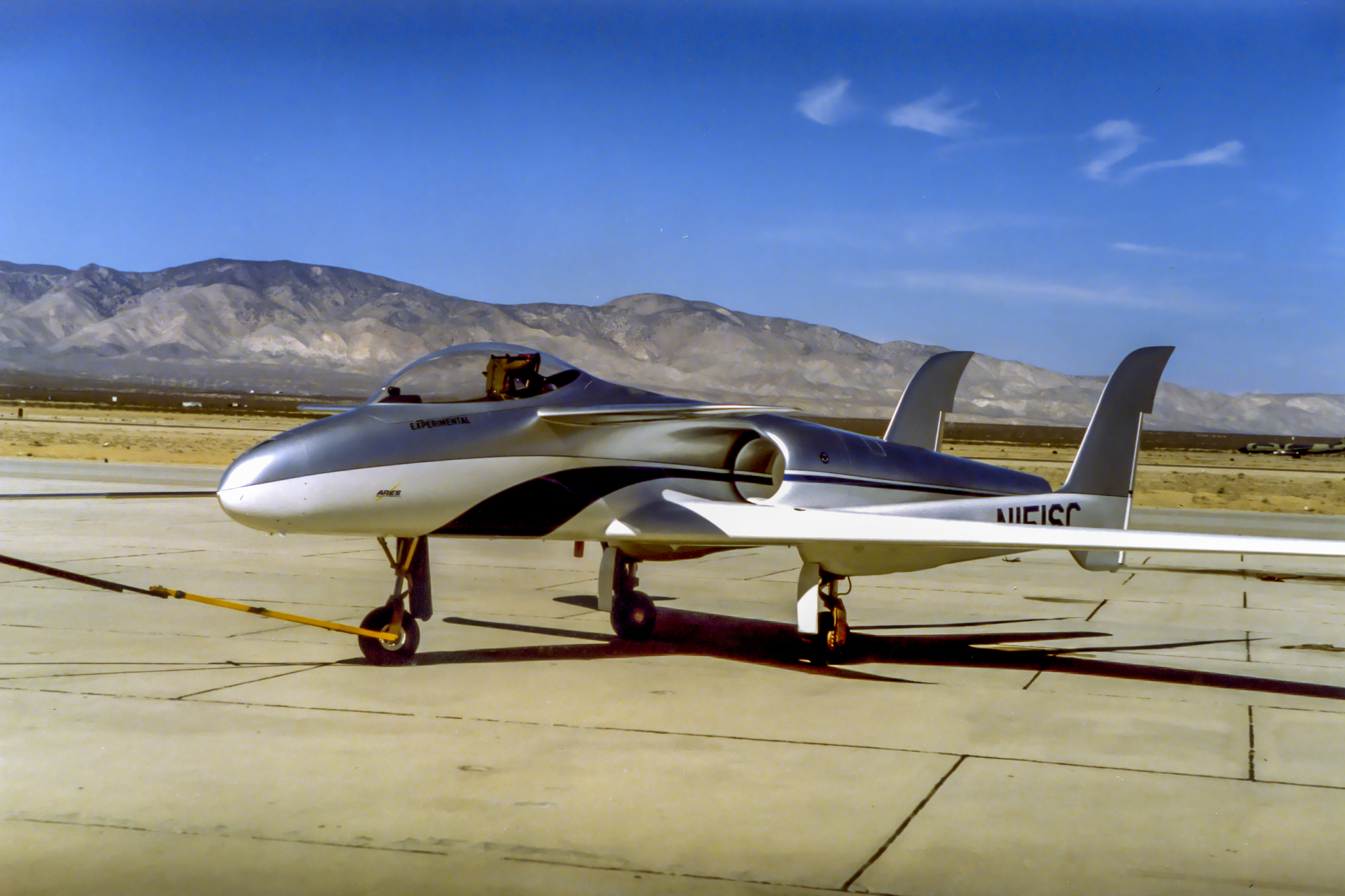The Killer Bee: A British technical liaison’s view of the Rutan ARES close air support aircraft

“In early 1990, I was asked to visit Scaled Composites at Mojave to gain information on the Ares light support aircraft. At the time, I was working for the British Embassy in Washington DC in a technical aerospace liaison role, working mainly with US Government Agencies, but occasionally with US Industry, and seeking to promote technical collaboration in Aerospace.

I welcomed the opportunity to visit Scaled Composites. As an aerodynamicist and an air vehicle configuration specialist, this would provide an opportunity to see a new product from the always imaginative Burt Rutan, and would also provide an opportunity to catch up with NASA projects at the nearby NASA Dryden (now NASA Armstrong), at Edwards Air Force Base.
I visited Scaled Composites on the 26th Feb 1990, one week after Ares had made its first flight, and attended a presentation of the aircraft to local media, industries and others.
Ares was the Greek God of war, and Scaled Composites had also turned ARES into an acronym for its Agile Response Effective Support aircraft. The design was described at the time as an anti-helicopter and light support aircraft, with potential customers being the US Customs Service and possible the US Army or Marines. The intent was that the demonstrator would validate the concept and that further development would enable a variety of other roles to be developed.


The aircraft is of unusual design, essentially resembling a turbofan-powered configuration similar in size and shape to a Rutan Long-Eze, wrapped around a GAU-12U 25-mm multi-barrelled cannon. The design is dominated by the arrangements made to accommodate the cannon, which is mounted in a payload bay on the starboard side of the aircraft. To avoid any problems with gun gas ingestion, the Pratt & Whitney JT-15D engine is mounted at an offset of 8 deg and fed by a single intake on the port side of the fuselage, with a curved jet pipe exhausting parallel to the fuselage longitudinal axis.
The attached photos of the aircraft were taken on the visit and show the unusual layout of the aircraft. The demonstration flight made on the day was the 5th flight of the aircraft.
This is video is quite impressive, showing the aircraft manoeuvring nimbly at low level around rough terrain in California, firing trials with the cannon, and Burt Rutan explaining the features of the aircraft.
At the time, I thought this was a neat little design, with an original approach to packaging a large gun into a small airframe. I was sceptical of how such an aircraft could contribute to UK capability, but could see the potential for an air policing or border protection role for others.

Now, the design looks well ahead of its time. With the ability to carry external stores on 4 hardpoints as well as the cannon, ARES would have been a fast and flexible counter-insurgency asset, offering much greater speed than competitors derived from turbo-prop agricultural aircraft or trainers.
Having made this initial visit, I included a visit to Mojave on a couple of other occasions. Among other projects, Scaled Composites built the composite delta wing for the Pegasus air-launched small satellite deployment system, and claimed this as the fastest and highest altitude composite wing, travelling at greater than Mach 5 and up to 200,000 ft. The company has built many notable products, including the Voyager and Global Flyer; and the White Knight 1 and 2 and Spaceship 1 and 2. They are building the Stratolauncher, which will have the largest wingspan of any aircraft yet flown, with a view to providing an airborne satellite launch system.”
Jim Smith had significant technical roles in the development of the UK’s leading military aviation programmes from ASRAAM and Nimrod, to the JSF and Eurofighter Typhoon.
Follow my vapour trail on Twitter: @Hush_kit

Almost a modern version of the similar arrangement Vought Cutlass, but with the forward lift/control surfaces that the Cutlass needed but didnt have. Apparently the arrangement gives a very stable platform that both planes shared.
Had Rutan thought to ‘play’ with the fore Canards a bit more, in location, form, build, sweep-angle, and sizing, this plane, coupled with an un-stable FBW, could’ve done things Way too nimble for most Acrobatic Bi-Planes, at twice the speed.
The 25mm Bushmater is a good gun, about as big as this airframe could handle, yet able to take on most known ground threats it’s likely to encounter.
It really is only lacking a decent Radar/Counter-ECM kit to protect itself in the ‘low-intensity’ simpler combat arena of FAC and Ground-support the US and a few of it’s Allies use in static warfare.
It would need an over-all, 130% increase is size/power/range to do what the Marines would want as an ‘escort’ for Osprey landings, but, heck, it’d be a Leatherneck’s best friend if that occurred.
I still wish this idea had been moved forwards, and developed further, without getting too expensive/complicated nor Big. DARPA should look twice at it.
The design of the plane looks heavily influenced by the defense reformers in the US military, who wanted a close air support plane without the excesses of the A-10.
Clearly the plane is designed around the gun. The A-10 was designed around a powerful 30mm gatling gun and they found that the gasses from the gun firing was a problem. So the Ares went through an unusual contortion so that the gun gasses wouldn’t choke out the engine.
There’s other stuff in there like the delta configuration. Pierre Sprey talks about the importance of the buttonhook turn. If a plane can quickly decelerate and turn quickly, it can quickly strafe several tanks before they have a chance to take countermeasures against an air attack. (Tanks usually travel in packs during a war.)
The aerobatic-ness of the plane may help it jink to dodge anti-aircraft gunfire as it comes in to make an attack pass.
The engine may be a high-bypass version of the JT-15D so that the exhaust is cool, making it harder to shoot down the plane with an infra-red missile.
The bubble canopy and short nose provides better visibility for spotting tanks and infantry hiding under camoflauge, similar to the A-10.
The plane is small (relative to the A-10), making it cheaper and harder to spot. The gun however is less powerful than the A-10’s. Perhaps the idea is to demonstrate the concept (e.g. stability of firing the gun and having the gasses cancel out the recoil) and have the production version of the plane use a 30mm cannon. Or, this was a compromise needed to make everything work.
It seems that the plane was specifically designed for military use. However, because the US Air Force doesn’t like cheap planes and doesn’t like the defense reformers, politics turned against Ares. Scaled Composites then tried to sell the plane for other uses.
Clearly the plane is designed around the gun. The A-10 was designed around a powerful 30mm gatling gun and they found that the gasses from the gun firing was a problem. So the Ares went through an unusual contortion so that the gun gasses wouldn’t choke out the engine.
There’s other stuff in there like the delta configuration. Pierre Sprey talks about the importance of the buttonhook turn. If a plane can quickly decelerate and turn quickly, it can quickly strafe several tanks before they have a chance to take countermeasures against an air attack. (Tanks usually travel in packs during a war.)
The aerobatic-ness of the plane may help it jink to dodge anti-aircraft gunfire as it comes in to make an attack pass.
The engine may be a high-bypass version of the JT-15D so that the exhaust is cool, making it harder to shoot down the plane with an infra-red missile.
The bubble canopy and short nose provides better visibility for spotting tanks and infantry hiding under camoflauge, similar to the A-10.
The plane is small (relative to the A-10), making it cheaper and harder to spot. The gun however is less powerful than the A-10’s. Perhaps the idea is to demonstrate the concept (e.g. stability of firing the gun and having the gasses cancel out the recoil) and have the production version of the plane use a 30mm cannon. Or, this was a compromise needed to make everything work.
It seems that the plane was specifically designed for military use. However, because the US Air Force doesn’t like cheap planes and doesn’t like the defense reformers, politics turned against Ares. Scaled Composites then tried to sell the plane for other uses.